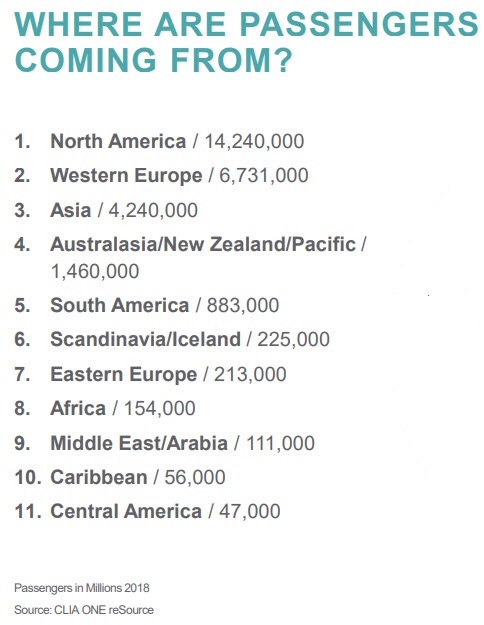CLIA: Thirty-Two Million Cruise Passengers Expected in 2020
The Cruise Lines International Association (CLIA) has released its 2020 State of the Cruise Industry Outlook report which indicates cruising sustained 1,177,000 jobs equaling $50.24 billion in wages and salaries and $150 billion total output worldwide in 2018.
According to the newly released CLIA 2018 Global Economic Impact Analysis, passengers spend $376 in port cities before boarding a cruise and spend $101 in each visiting port destination during a cruise. North America accounts for the highest rate of cruisers with 14.2 million North Americans cruising in 2018.
32 million passengers are expected to set sail in 2020. Marriage rates are declining and the number of single adults is growing globally. As a result, cruise lines are responding to the shift in passenger demographics by offering studio cabins, single-friendly activities, eliminating single supplements and solo-lounges.

Trip duration is continuing to change, with many travelers looking for quick trips. Cruise lines are offering bite-sized cruises over a three-to-five-day period offering shorter itineraries to a variety of destinations.
To meet ongoing demand, CLIA Cruise Lines are scheduled to debut 19 new ocean ships in the upcoming year, resulting in a total of 278 CLIA Cruise Line ocean ships projected to be in operation by the end of 2020.

44 percent of newbuild capacity will rely on LNG fuel for primary propulsion and 75 percent of non-LNG newbuilds will have exhaust gas cleaning systems. All newbuilds will have advanced waste water treatment systems, and 88 percent will have or be configured for shore power.
The State of the Cruise Industry Outlook found more travelers are spending time in and near cruise ports. 65 percent of cruise passengers spend a few extra days at embarkation or debarkation ports.
The report finds an industry-wide commitment to responsible tourism practices, with a focus on environmental sustainability and destination stewardship. The report highlights the industry’s $22 billion investment in the development of new energy efficient technologies, partnerships with local governments in key destinations and a commitment to reducing its rate of carbon emissions by 40 percent by 2030 compared to 2008.
The report is available here.
